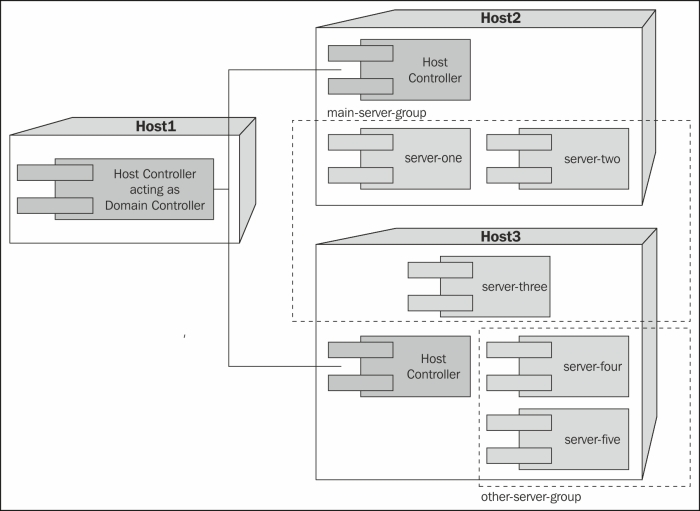This chapter will provide you with a crash course in the new application server so that we will be able to deploy our first Java EE 6 application in the next chapter. More specifically, we will cover the following topics:
- An introduction to the AS 7 core concepts
- The anatomy of the JBoss AS 7 filesystem
- An introduction to the available management instruments
- Deploying your first HelloWorld application
Now that we have downloaded and installed JBoss AS 7, it is worth familiarizing ourselves with some basic concepts. Initially, JBoss AS 7 can be run in two modes: the standalone mode and the domain mode.
In the standalone mode, each JBoss Application Server 7 instance is an independent process (similar to the previous JBoss AS versions, such as Version 4, Version 5, or Version 6). The standalone configuration files are located under the standalone/configuration of the application server.
In the
domain mode, you can run multiple application servers and manage them from a central point. A domain can span multiple physical (or virtual) machines. On each machine we can install several instances of JBoss Application Server 7, that are under the control of a Host Controller process. The configuration files in the domain mode are located under the domain/configuration folder of the application server.
From the process point of view, a domain is made up of three elements:
- Domain Controller: The domain controller is the management control point of your domain. An AS instance running in the domain mode will have, at the most, one process instance acting as a domain controller. The domain controller holds a centralized configuration, which is shared by the node instances belonging to the domain.
- Host Controller: It is a process that is responsible for coordinating the lifecycle of server processes and the distribution of deployments from the domain controller to the server instances.
- Application server nodes: These are regular Java processes that map to instances of the application server. Each server node, in turn, belongs to a domain group. Domain groups are explained in detail when we discuss the domain configuration file.
Additionally, when starting a domain, you will see another JVM process running on your machine: this is the Process Controller. It is a very lightweight process whose primary function is to spawn server processes and Host Controller processes, and manage their input/output streams. Since it is not configurable, we will not discuss it any further.
The following diagram depicts a typical domain deployment configuration:

As you can see from the preceding screenshot, one host (Host1) acts as a dedicated domain controller. This is a common best practice adopted in domain-managed servers in order to logically and physically separate the administration unit from the servers where the applications are hosted.
The other hosts (Host2 and Host3) contain the domain application servers, which are divided into two server groups: main-server-group and other-server-group . A server group is a logical set of server instances that will be managed and configured as one. Each server group can in turn be configured with different profiles and deployments; for example, in the preceding domain you can provide some services with server-group-one and other services with other-server-group.
Going into the details of the domain configuration is beyond the scope of this book; however, by the end of this chapter we will show how to deploy application units in a domain using the Command Line Interface available in AS 7.
